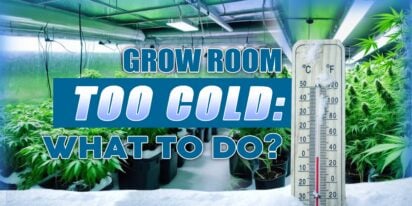
Are You 18 Or Over?
YesOr
No By clicking yes, you certify that you are over 18. By using this website, you agree to our legal disclaimer.Table of Contents

Table of Contents
Autoflowering cannabis plants have a set growth cycle, going from seedling to vegetative to flowering stages. Knowing these stages well helps diagnose and fix growth problems. Each stage has its challenges and needs for good growth. When growers understand these stages, they can take better care of their plants to make them healthier and more productive.
The first thing to do when fixing stunted growth is to notice the signs. Apart from obvious slow growth and small plants, watch out for other signs like yellow leaves, short spaces between leaves, and weak plants. Keep a close eye on your plants all the time. If you see any issues, fix them quickly. This will help your autoflowers grow healthier and stronger.
Stunted growth in autoflowers can happen because of different reasons, like environment or genetics. Bad growing conditions, like not enough light, wrong humidity, or very hot or cold temperatures, can slow down growth. Also, some strains might be more likely to have stunted growth. Not having enough nutrients or having the wrong balance of them can also cause problems and stop the plant from growing well. When growers know why their plants aren’t growing well, they can find solutions to fix each problem.
Making the right environment is crucial for healthy autoflower growth. Give your plants enough light, water, and air all the time. Keep an eye on temperature and humidity to keep them in good conditions and help them use sunlight well. Also, think about things like pH levels and what your plants are growing in, because these can affect how well they get nutrients. When you keep the conditions just right, your plants will grow well and you’ll get the most yield from them.
Giving autoflowers the right nutrients is key for strong growth. Use a balanced fertilizer that has all the important nutrients, both big and small. Test your soil often to see how many nutrients are in it, and change how you feed your plants based on the results. Watch how your plants use nutrients and fix any problems, like yellow or weird-looking leaves, quickly. You can also add natural stuff or extra things to your soil to make it better for your plants. When you take care of nutrients well, you’ll get the best harvest with good taste and strength.
Trimming and shaping your plants can reduce stunted growth and make them grow more branches and buds. Try methods like cutting the top off, bending branches gently (called low-stress training), and taking off some leaves to let in more light and air. These tricks make your plant’s shape better and help buds grow more evenly. When you remove extra leaves and focus on making buds, your plants can make more buds and better-quality crops. Test out different ways to trim and see what works best for your plants, changing as needed to get the results you want.
Bugs and diseases are big problems for autoflowers and can make them grow slowly if you don’t stop them. Do things like checking your plants often, keeping things clean, and using strategies that mix different ways to control pests (called integrated pest management). If you can, pick plants that bugs don’t like, and don’t bring in soil or plants that might have bugs or diseases. If your plants do get bugs, treat them quickly with natural or chemical methods to stop them from hurting your plants too much. When you keep a close watch on pests and diseases, you’ll keep your plants safe and get the best crops possible.
Dealing with stunted growth in autoflowers needs a comprehensive plan that looks at everything from the environment to genetics and nutrient care. By finding out why your plants aren’t growing well and fixing those problems, you can help them grow strong and give you more buds. Keep watching your plants closely and change how you take care of them as needed. With patience, hard work, and a focus on doing your best, you can overcome challenges and get great results from your autoflower cultivation.
Q: How can I tell if my autoflower is stunted?
A: Signs of stunted growth include slow development, small stature, and pale or discolored leaves. Additionally, stunted autoflowers may exhibit reduced vigor, with undersized buds and sparse branching.
Q: What causes stunted growth in autoflowers?
A: Stunted growth can result from a combination of environmental stressors, genetic factors, and nutrient imbalances. Common culprits include inadequate lighting, extreme temperatures, poor soil quality, and insufficient or excessive nutrient levels.
Q: Can stunted autoflowers recover?
A: With proper care and intervention, stunted autoflowers can often recover and resume healthy growth. By addressing underlying issues such as nutrient deficiencies, environmental stress, or pest infestations, growers can facilitate recovery and encourage new growth.
Q: How can I fix nutrient deficiencies in my autoflowers?
A: To address nutrient deficiencies, start by conducting a soil test to identify specific imbalances. Then, adjust your fertilizer regimen accordingly, supplementing with appropriate nutrients to meet plant needs. Consider using organic amendments or foliar sprays for rapid nutrient uptake and absorption.
Q: Are there any natural remedies for pest control in autoflowers?
A: Yes, several natural remedies can effectively control pests in autoflowers without resorting to chemical treatments. Examples include neem oil, insecticidal soap, diatomaceous earth, and predatory insects such as ladybugs or lacewings. These eco-friendly alternatives help manage pest populations while minimizing harm to beneficial organisms and the environment.
Q: What is the optimal temperature range for autoflower growth?
A: Autoflowers thrive in temperatures between 70-85°F (21-29°C) during the day and slightly cooler temperatures at night. Maintaining consistent temperatures within this range promotes healthy growth, robust metabolism, and optimal resin production, resulting in high-quality harvests.

In the realm of cannabis culture, the practice of "wake and bake" holds a significant place, accompanied by both supporters and skeptics. As exp

In recent years, the discourse surrounding secondhand marijuana smoke has gained significant attention, paralleling the legalization and increas

In the realm of cannabis culture, the practice of "wake and bake" holds a significant place, accompanied by both supporters and skeptics. As exp

Introducing the robust indica strain known as Critical Mass weed, a harmonious fusion of Afghani and Skunk #1 genetics. Delve into its essence,

Fusarium wilt cannabis represents a significant threat to cannabis cultivation, necessitating a comprehensive understanding of its intricacies.

1980s were a time of profound cultural transformation, marked by iconic fashion, music, and movies. Alongside these trends, a unique facet of '8

[ez-toc] In the deep history of cannabis cultivation, there exists a captivating and creative practice that combines the art of cultivation wit

For growers looking to get better yields and healthier cannabis plants, it's important to understand and control the cannabis soil pH levels. pH

[ez-toc] In indoor gardening, maintaining an optimal temperature within your grow tent is crucial for the health and productivity of your plant

[ez-toc] Welcome to the delightful world of cannafudge crafting, where sweetness meets sophistication, and cannabis infusion adds a unique twis

Are You 18 Or Over?
YesOr
No By clicking yes, you certify that you are over 18. By using this website, you agree to our legal disclaimer.